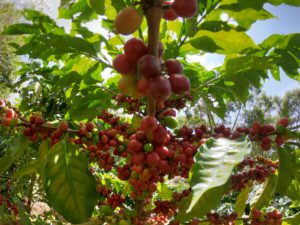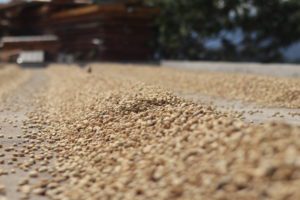Nowadays, we purchase coffee from dynamic businesses fed by trade relationships we usually take for granted. From dragon fruit to maple syrup, to avocadoes, stores and shops offer a variety of non-native crops and plant-based products. Foods harvested in exotic places make their way to our stores thousands of miles away. They’ve been shipped from far-off lands, yet don’t carry huge price tags. Coffee beans and ground coffee rank with corn, wheat and sugar cane for crops that consistently travel long distances in large volumes. The world loves coffee!
Coffee beans may be the most luxurious plant product that travels long distances regularly to be consumed around the world. No one needs coffee in their diet. Whether someone needs it to maintain their work ethic, sociability or zest for life is another story. Here at Subida Coffee in Honduras, we know why the world loves coffee. Interestingly, bananas, another Honduran crop, are the most often shipped fruit, as measured by weight. But let’s see where and when the beans (seeds) inside coffee fruit first became popular.

Ancient but Fun Origins
Although we wouldn’t think pets or farm animals would enjoy a sip of our dark brews, coffee fruit is a different level of appetizing to some of our furry friends. Although most sources focus on a goat herder named Kaldi whose goats became energetic after eating coffee fruit, archaeological evidence of coffee fruit consumption exists from over 100,000 years ago. Considering that fruit was an easily procured type of food when life was more struggle-laden, it’s no surprise humans ate coffee cherries.
Nevertheless, the somewhat legendary tale of Kaldi the goat herder makes for a fun story of a possible moment when coffee was first noticed for its energizing properties in Ethiopia. Uncaffeinated goats jump and have a rep for being great escape artists. So perhaps this purported origin story would make a great coffee bag label with a springing goat. If coffee company marketing drifts in the fun direction that craft beer naming and labeling has, we’re sure a goat will spring up and off a coffee package soon.
Entering Arabia
The world’s most popular coffee bean today is Arabica, which pays homage to the next development in coffee’s history. Coffee made its way to the Arabian Peninsula through trade by the 1600s. It was grown in the Yemeni area. The scale of coffee growth in Arabia grew. It became so large that in later colonization efforts, the Arabian Peninsula was the area serving as a model to be duplicated and competed with.
Coffee moved on, spreading as far north as Turkey and as far east as Persia (present-day Iran). There, the coffee house became a meeting place diametrically opposed to the taverns popular in Europe. Deep thought and fast-paced discussions prevailed in coffee houses.
When coffee spread to Europe, the sharpened mind and ability to engage in wider thought led coffee houses to be known as “penny universities” in England. Almost as soon as people inhabited present-day New York, coffee arrived in the 17th century. The Dutch began growing it in Indonesia. Connecting coffee’s nickname “Java” and the “Sumatra” type of coffee to Indonesia can be a lightbulb moment, or just a reminder, pointing to their origin.
How Did Coffee Reach Honduras?
Coffee entered the new world through three points around present-day Honduras. But which path did the beans follow to arrive there? Coffee was enjoyed by drinkers in (formerly Dutch) New York to the far northeast of Honduras. Coffee also grew on the French island of Martinique almost due east in the Caribbean. It entered Brazil to the southeast by way of French Guiana. Of the three possibilities, it was French Martinique. This island sent coffee by water to Central America and Honduras. That was after a single seedling had led to the development of an enormous and successful coffee operation in Martinique.
Compared to coffees from other regions, in the worldwide coffee belt, Central American coffees are well balanced with clean finishes. Coffee in Honduras tends to range from light to full-bodied, with sweet finishes and notes of fruit and caramel. Decades ago, Honduran beans were mostly destined for blends. Nowadays, they are being appreciated alone in single-origin coffees.

Cacao – Coffee’s Sweeter, Calmer Cousin
While coffee originated in Ethiopia, in Honduras, a stimulant cousin drank in liquid form is native to the Americas. The cacao plant produces chocolate. And most of us love chocolate notes in our coffee from time to time. Cacao was a sacred drink, a delicacy of the Maya, who are native to Honduras. According to Flykakao:
“The word ‘cacao’ stems from the Olmec and Mayan word 'kakaw'. 'Xocolatl' in the Aztec Nahuatl language means ‘bitter water' or 'bitter drink’. This is where the modern word ‘chocolate’ comes from.”
The alias “bitter water” sure sounds like the opinion of many a child after trying coffee!
The cacao tree originates from the upper Amazon region in Colombia, Peru and Ecuador. Cacao made its way from the Ecuadorian Mayo-Chinchipe people to other Mesoamerican groups like the Inca, Aztecs, Toltecs and Olmecs. The Aztecs even used cacao as currency. The Maya inhabited the Copán region, where we grow and harvest coffee today. The fruit and seed were used as far back as 2,000 BCE in Honduras.
Honduran Coffee Today
Although not originally native to the Americas, coffee grows supremely in Central America. The wet, sunny, mountainous regions of Honduras are perfect for producing delectable coffee. Situated at 1,200 meters (3,900 feet), Santa Rosa de Copán is a beautiful town—that produces beautiful, gourmet coffee.
One coffee farm outside of Santa Rosa produces the Subida line of coffees. Not only do the dark and medium roasts taste great, they support a wonderful cause. Subida is made on the site of a program called the Moses Project, which educates and empowers teenage boys. The 120-acre commercial farm and agricultural training center produces stellar coffee and helps train the next generation. They can stimulate the Copán region through agriculture and other endeavors. 100% of the profit from coffee sales supports the non-profit’s efforts.

In Honduras, coffee growth can help bring the economy to the next level. It’s the most valuable agricultural export, and coffee prices have risen recently. Today, the coffee bean powers the world’s humans (and probably still a fruit-loving goat or two). Purchasing Honduran coffee does a lot of good.

